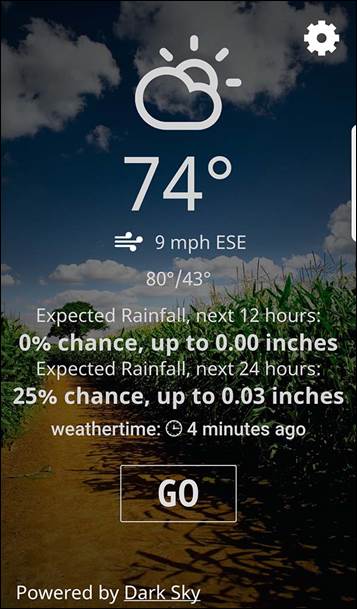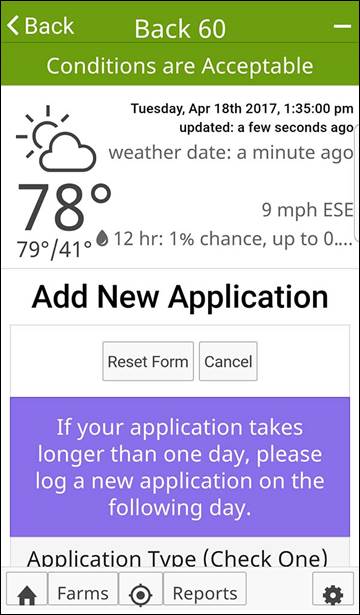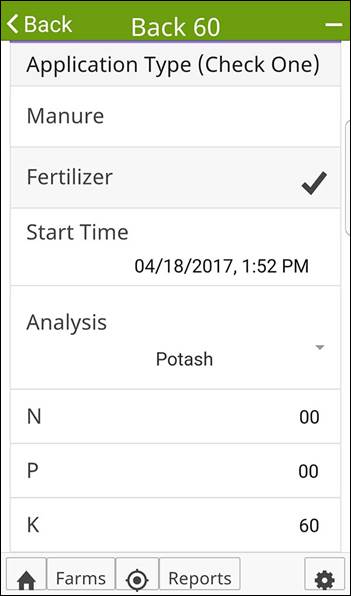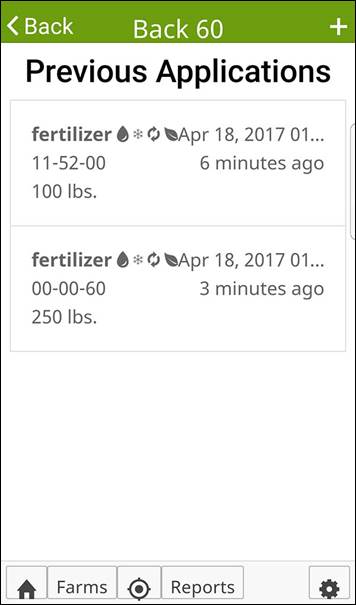 |
August 2017
|
August 2017 // Volume 55 // Number 4 // Tools of the Trade // v55-4tt2
Nutrient Record Keeping . . . Yep, We've Got an App for That!
Abstract
Technological advances continue to shape agriculture. Many farmers are now using mobile devices to manage their businesses and farming operations "from their shirt pockets." Concurrently, new regulations in Ohio involve a record-keeping requirement. In certain areas of the state, regulations pertaining to weather data and soil conditions restrict fertilizer and manure applications. To assist farmers in meeting these requirements, a multiagency group developed the Ohio Nutrient Management Record Keeper app. This app is available for iOS, Android, and web-based platforms.
Introduction
Today technology is creating sweeping changes on many Ohio farms. The advancement of electronic technology allows users to have educational materials and other useful information, such as mapping features, literally at their fingertips (Dvorak, Franke-Dvorak, & Price, 2012). The current county-based delivery of Extension education is failing to serve a progressive and growing constituency that not only desires but also expects to find all forms of education and information online (Diem, Hino, Martin, & Meisenbach, 2011). Farmers are part of that constituency, and many now desire instant access to data. Accommodating the demand for quick answers in agriculture requires that Extension provide innovative delivery of services by applying current technology trends (McCornack & Johnson, 2016). According to a 2015 Farm Journal Media survey, 69% of the responding farmers owned smartphones, and another 18% expected to add the technology in 2016 (Potter, 2015). Likewise, the findings suggested that tablet use would increase to 59% by 2016 (Potter, 2015). Farmers have always gathered daily information about their farming operations. Today, however, the smartphone or tablet is replacing the pad of paper in a farmer's front pocket.
Two Ohio laws now restrict nutrient applications and require documentation of fertilizer and manure applications. In 2015, Ohio lawmakers enacted legislation requiring farmers to record detailed information regarding fertilizer applications, including relevant weather forecast data. Farmers must document the information within 24 hr of an application. A separate statute requires farmers in counties located in watersheds that encompass the Western Basin of Lake Erie to comply with restrictions on nitrogen and phosphorus applications, whether applied as manure or granular fertilizer. This statute requires applications based on soil conditions, weather forecast data, application method, and cropping environment.
This article explains how the Ohio Nutrient Management Record Keeper (ONMRK) app allows Extension educators to incorporate new technology in program delivery, aid farmers in meeting legislative requirements, and involve new technology in teaching best management practices.
Development
The development of the ONMRK app was a combined grassroots effort of the Ohio State University Extension–Knox County office, Ohio Farm Bureau, Knox County Soil and Water Conservation District, and Muskingum Watershed Conservancy District. Those of us involved in designing the app had three goals in mind:
- to make a quick and easy digital option farmers could use to record application data,
- to give farmers the ability to record current and future weather forecast data at the time of application, and
- to provide a digital platform for meeting the record keeping requirement of the new state legislation.
Because Android and iOS operating systems accounted for 94% of the mobile/tablet market share in 2016 (Netmarketshare.com, 2016), we designed the ONMRK app for Android, iOS, and web-based platforms. The various versions of the application are available as free downloads from the Google Play Store and iTunes. The web-based version is at www.onmrk.com.
Using the ONMRK App
Performing the Initial Setup
To use the downloaded app, the user must complete an initial registration at the ONMRK website (https://onmrk.com/). Through this registration, the user creates a unique applicator key. Upon opening the app for the first time on a mobile device, the user must enter his or her applicator key (Figure 1). After the user signs in, the home screen displays, showing both the 12- and 24-hr forecasts (Figure 2). After registering, the user enters initial farm and field setup information from either the mobile device or a home computer.
Figure 1.
ONMRK Login Screen

Figure 2.
ONMRK Home Screen

Entering Data for a Fertilizer Application
Figures 3–7 show the data entry screens required to create an application. Mobile devices must be used for entering application data. The first time a user enters a field, he or she must confirm the location of the field. The ONMRK app uses the GPS capabilities of the mobile device to determine the user's location (Figure 3). After the user selects the proper field, the next screen indicates whether the weather forecast is favorable for the application (Figure 4).
Figure 3.
ONMRK Interface for Confirming Field Location

Figure 4.
ONMRK Recommendations Regarding Favorability of Weather Forecast
Relative to Planned Application

If conditions for application are acceptable, the user enters the following data:
- application type (user selects fertilizer or manure) (Figure 5),
- product analysis (user selects from drop-down list or enters custom analysis) (Figure 5),
- soil conditions (user selects from drop-down list) (Figure 6),
- method of application (user select from drop-down list) (Figure 6),
- indication of whether ground is frozen or snow covered (user checks box if applicable) (Figure 6),
- indication of whether product will be incorporated within 24 hr (user checks box if applicable) (Figure 6),
- indication of whether product is being applied to a growing crop (user checks box if applicable) (Figure 6),
- application rate per acre (user enters numeric value) (not shown),
- application units (user select from drop-down list) (not shown), and
- field notes (optional) (not shown).
Figure 5.
ONMRK Data Entry Fields for Application Type, Start Time, and
Nutrient Analysis Data

Figure 6.
ONMRK Data Entry Fields for Soil and Ground Conditions Data

Figure 7 shows results displayed after data were entered for two applications.
Figure 7.
ONMRK Previous Applications Screen

Accessing Reports
When a user saves application data in the app, a report showing to-date application activity generates automatically on the ONMRK website (Figure 8). The user can view, export in CSV format, or print this report.
Figure 8.
ONMRK Application Activity Report

Conclusions
Extension educators taught farmers how to use the ONMRK app during fertilizer certification meetings throughout Ohio in January, February, and March of both 2016 and 2017. As of April 21, 2017, there were 1,068 farming operations and 1,359 applicators using the web platform. Additionally, there were 6,483 iOS users and 608 Android users. These users had entered data for 2,521 farms, 5,439 fields, and 2,726 applications (Onmrk.com, 2017).
Today's technologies provide educators the opportunity to reteach or reinforce basic agronomic principles. The ONMRK app is a tool for providing a quick and easy record-keeping option for farmers who use mobile technology. Additionally, the app is a valuable teaching tool educators can use to teach best management practices, such as adherence to crop nutrient requirements, proper nutrient application and timing, soil testing, and long-term fertility management. Extension educators in any state can teach these topics by using the ONMRK app.
References
Diem, K. G., Hino, J., Martin, D., & Meisenbach, T. (2011). Is Extension ready to adopt technology for delivering programs and reaching new audiences? Journal of Extension, 49(6), Article 6FEA1. Available at: http://www.joe.org/joe/2011december/a1.php
Dvorak, J. S., Franke-Dvorak, T. C., & Price, R. R. (2012) "Apps"—An innovative way to share Extension knowledge. Journal of Extension, 50(6), Article 6IAW2. Available at: http://www.joe.org/joe/2012december/iw2.php
McCornack, B. P., & Johnson, W. A. (2016). Getting growers to go digital: The power of a positive user experience. Journal of Extension, 54(4), Article 4FEA2. Available at: http://www.joe.org/joe/2016august/a2.php
Netmarketshare. (2016). Market share statistics for Internet technologies. Retrieved September 15, 2016, from https://www.netmarketshare.com/operating-system-market-share.aspx?qprid=8&qpcustomd=1
Onmrk.com. (2017). Administrative dashboard. Retrieved from https://onmrk.com/dashboard
Potter, B. (2015). 87% of farmers will own a smartphone by 2016. Retrieved from http://www.agweb.com/article/87-of-farmers-will-own-a-smartphone-by-2016-naa-ben-potter/




